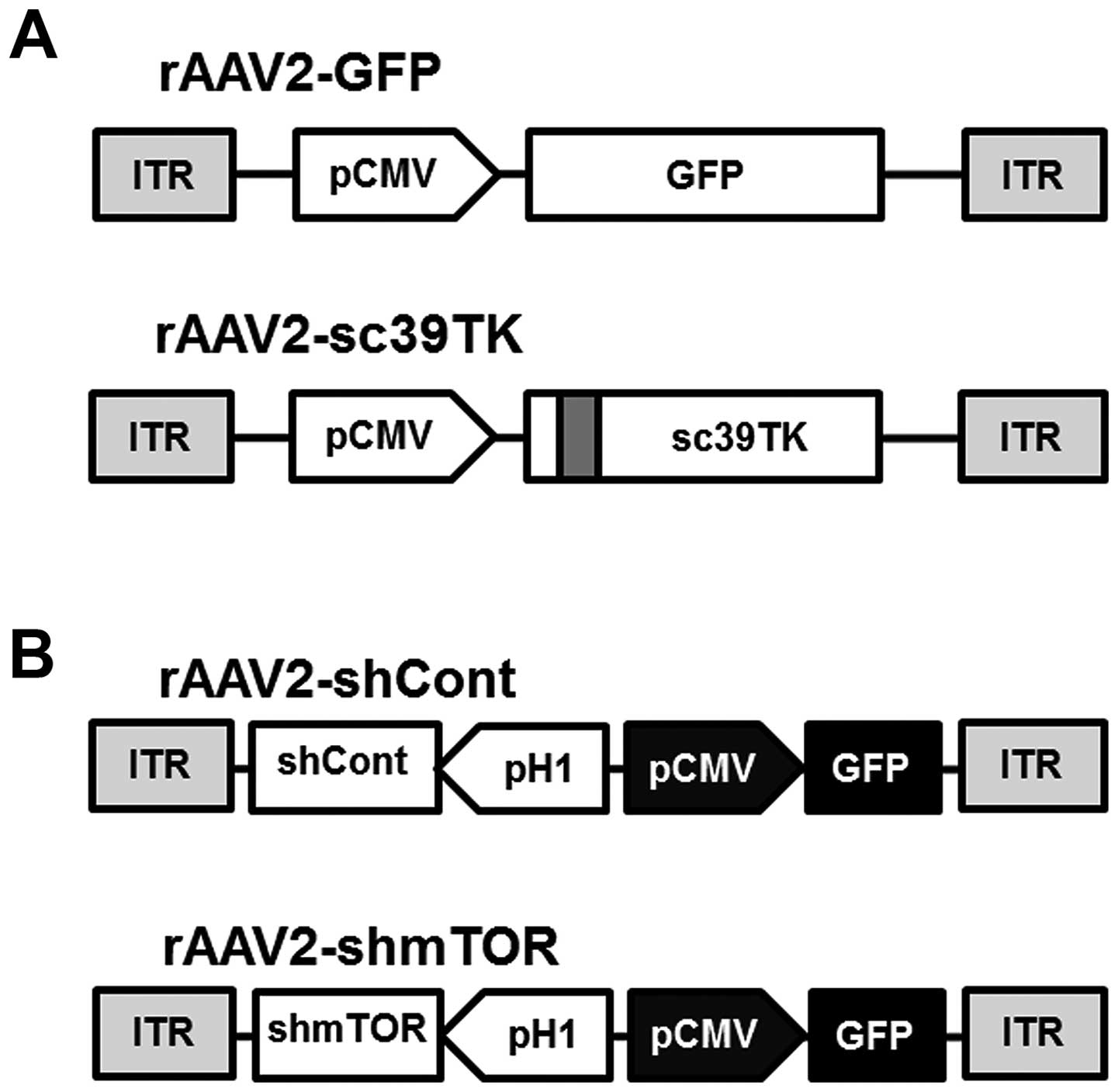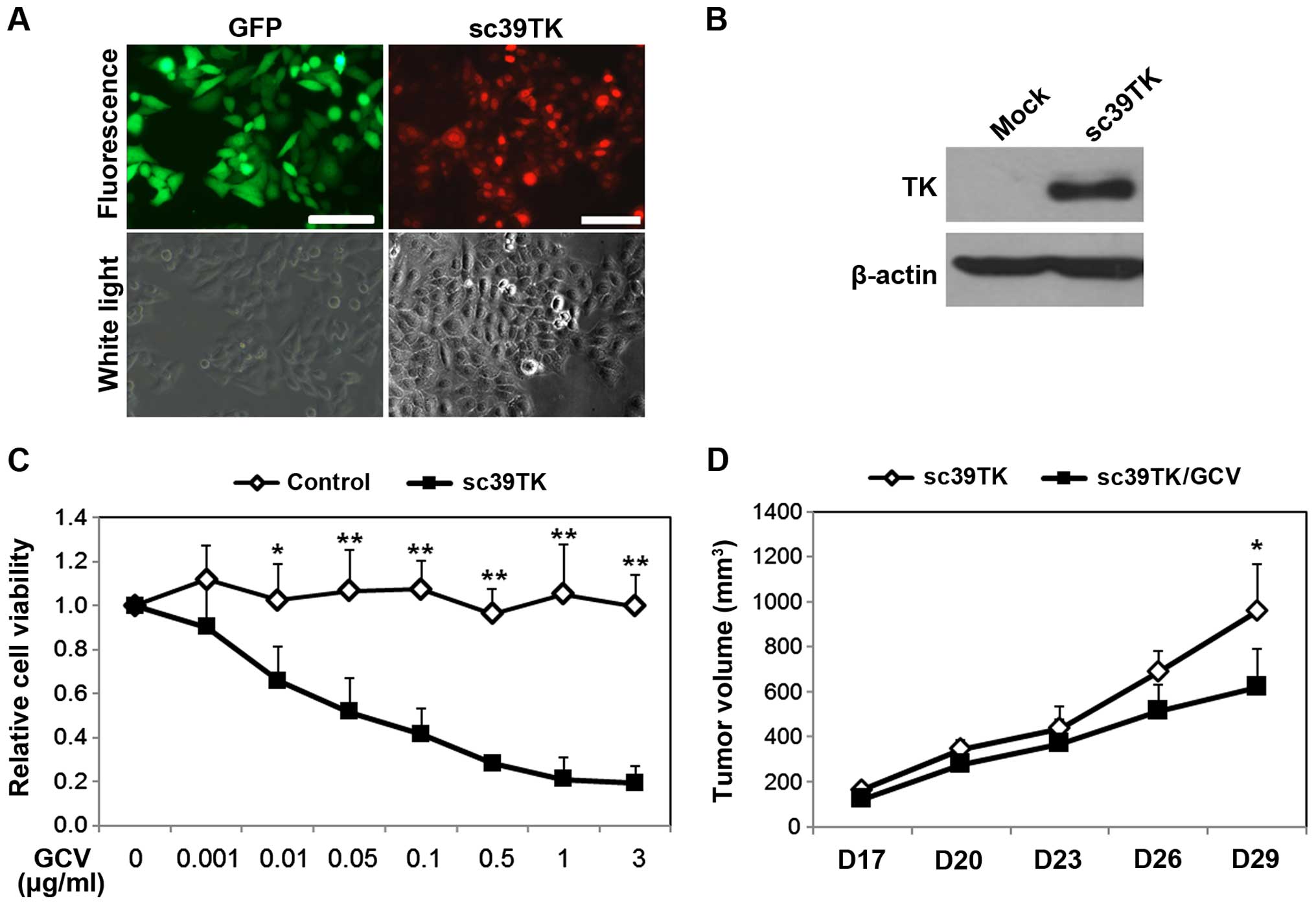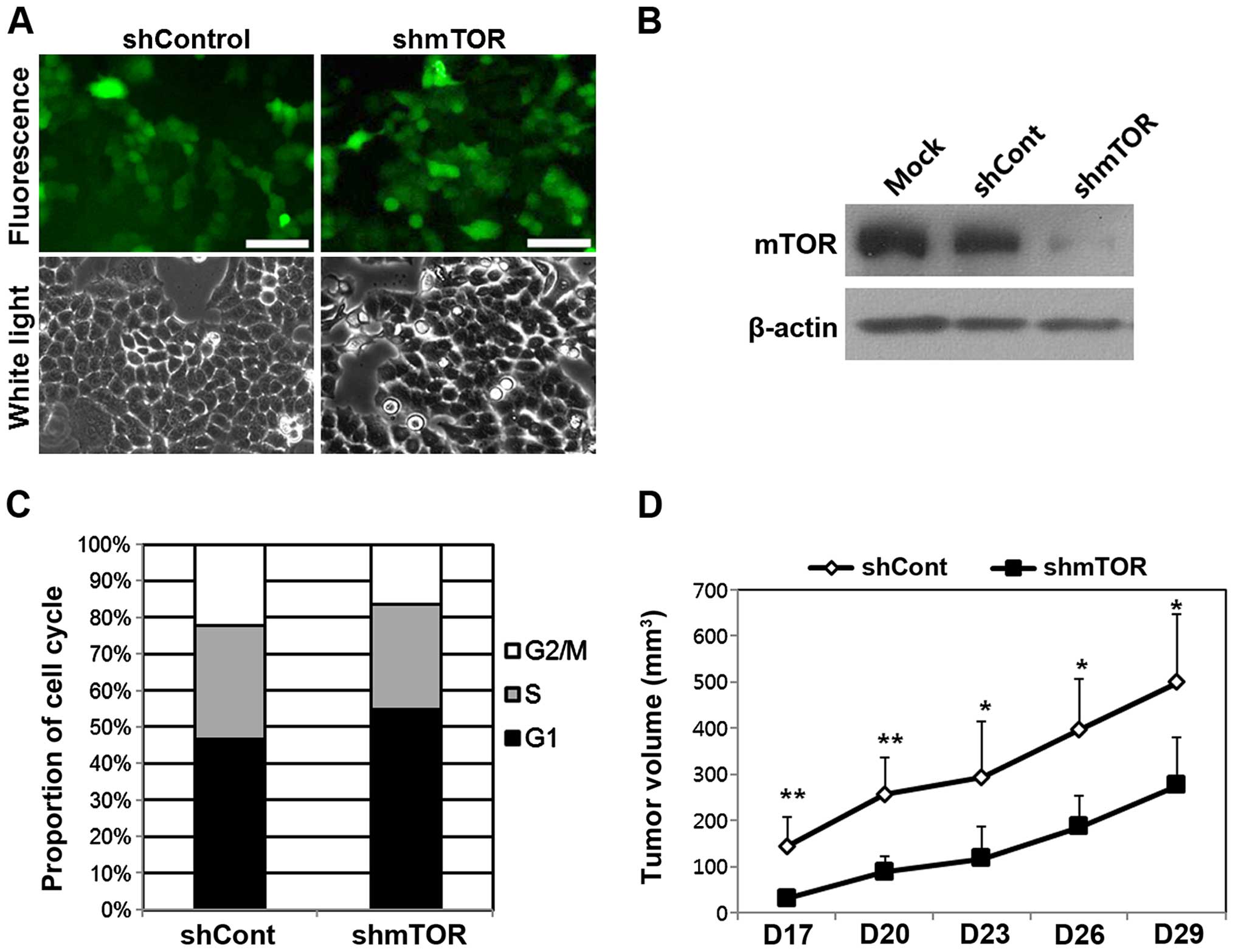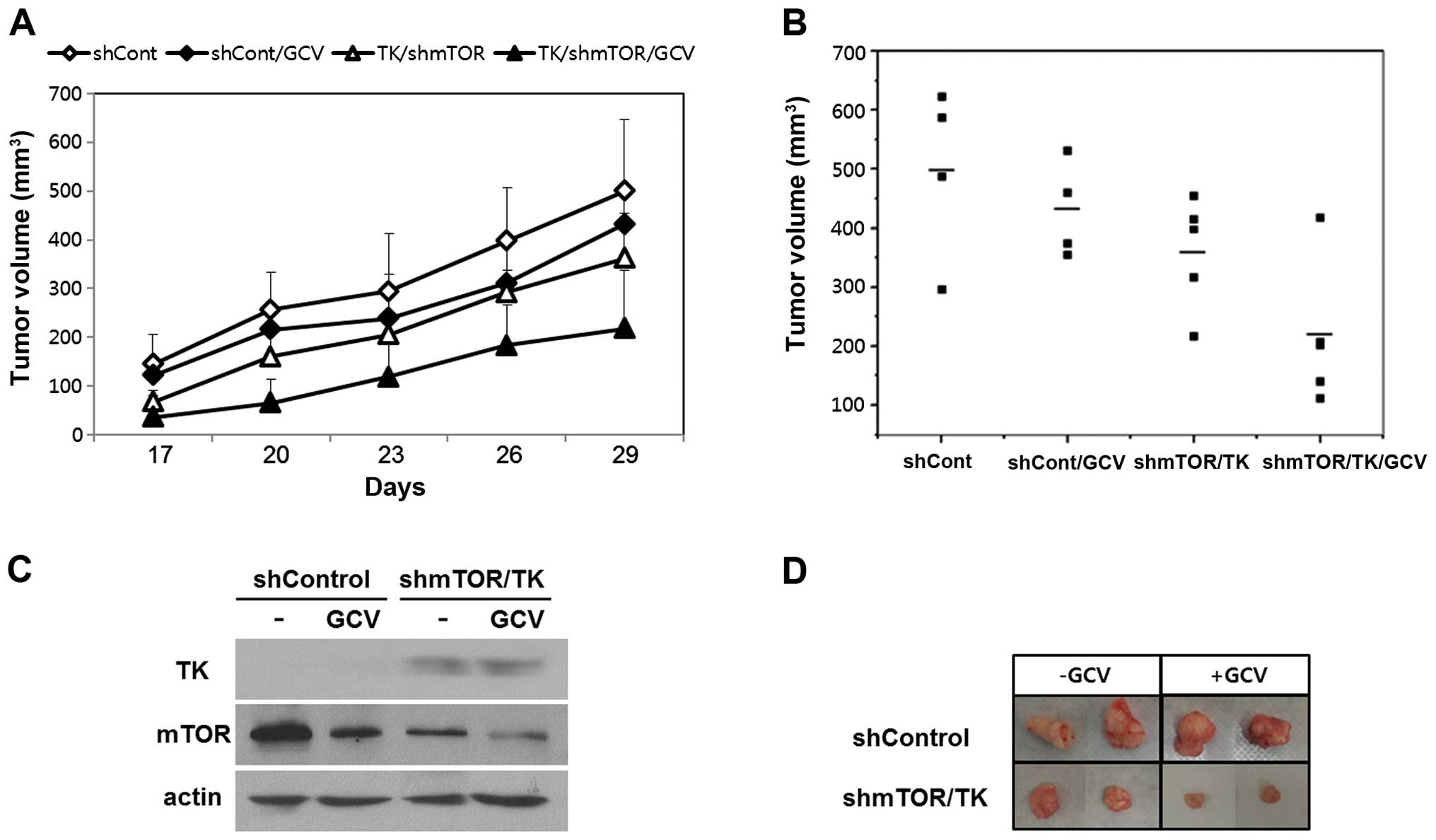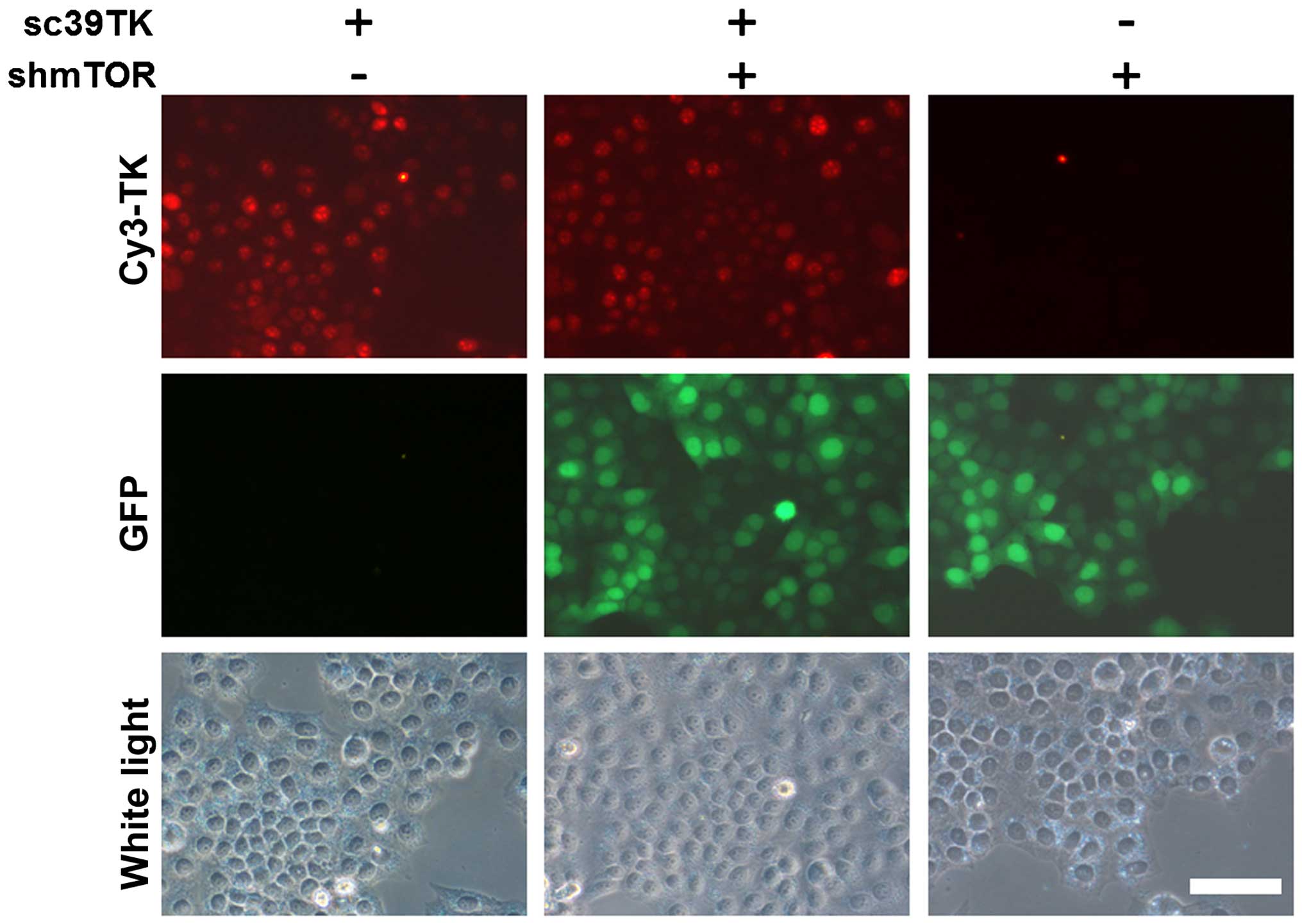Combined antitumor gene therapy with herpes simplex virus-thymidine kinase and short hairpin RNA specific for mammalian target of rapamycin
- Authors:
- Published online on: October 8, 2015 https://doi.org/10.3892/ijo.2015.3194
- Pages: 2233-2239
Abstract
Introduction
Gene therapy holds great promise for treating intractable tumors, and suicide gene therapy is one of the most promising strategies (1). The herpes simplex virus (HSV) thymidine kinase (TK) gene is the most widely applied suicide gene in clinical trials (2–5). TK catalyzes the phosphorylation of the prodrug ganciclovir (GCV) to generate the mono-phosphate form, which is converted by cellular kinases into di- and triphosphate forms that inhibit DNA synthesis (6) and induce apoptosis (7). Furthermore, by exerting the so-called ‘bystander effect’, toxic metabolites of GCV can kill neighboring non-transfected tumor cells, enhancing cytotoxicity (8). However, the effects of the TK-GCV system are suboptimal, and combination with another strategy is usually recommended (4,5).
Mammalian target of rapamycin (mTOR) is an evolutionally conserved serine/threonine protein kinase and is a target of antitumor therapy because it regulates cell growth and metabolism and also because its aberrant activation occurs in many types of tumors (9–11). In addition to rapamycin, the prototypical inhibitor of mTOR, several rapamycin analogs (rapalogs) show improved pharmacokinetic bioavailability and reduced toxicity (12–14). Moreover, rapalogs such as temsirolimus and everolimus have been approved by the United States Food and Drug Administration (FDA) for treatment of renal cell cancer and lymphoma (14,15). However, the mechanism of mTOR inhibition deserves further scrutiny because many tumors are extremely heterogeneous regarding their sensitivity to rapalogs. This can be explained in part by the complexity of mTOR signaling. mTOR comprises the mTOR complex 1 (mTORC1) and mTOR complex 2 (mTORC2), which interact in a negative feedback loop (11). Thus, inactivation of mTORC1 after the administration of traditional rapalogs leads to paradoxical activation of Akt, the upstream stimulator of mTORC1, by reactivating either the insulin receptor substrate-1 pathway or the mTORC2 pathway, diminishing the antitumor effects of a single rapalog (14–16). Further, simultaneous inhibition of mTORC1 and mTORC2 pathways or suppression of all mTORCs and PI3K-Akt pathways using chemical inhibitors is often unacceptably toxic to normal cells despite the improved antitumor effects (11,14). Therefore, a highly sophisticated approach is required if mTOR is to be considered as a therapeutic target for gene therapy.
Here, we developed a novel dual gene therapy strategy and confirmed its potential as a combination gene therapy in a uterine cervical carcinoma model. We employed a suicide gene (HSV-TK) and its prodrug (GCV) to inhibit DNA synthesis and a small hairpin RNA (shRNA) that targeted mTOR expression. Recombinant adeno-associated virus (rAAV) vectors were used for each strategy (17,18). Herein, we show that the combination of the TK-GCV system and mTOR inhibition was efficacious in our model system.
Materials and methods
Cell culture and reagents
Human cervical carcinoma HeLa cells were obtained from the American Type Culture Collection (Manassas. VA, USA). The cells were maintained in Dulbecco's modified Eagle's medium (Gibco-Invitrogen, Carlsbad, CA, USA) supplemented with 10% fetal bovine serum (Gibco-Invitrogen), GlutaMAX-1 (2 mM) and 1% penicillin (100 IU/ml)/streptomycin (50 μg/ml) in a humidified atmosphere containing 5% carbon dioxide at 37°C.
Construction of a recombinant adeno-associated virus
The rAAV vectors were constructed as previously described (19,20). The rAAV2 plasmid expressing splice-corrected 39TK (sc39TK) under the control of the CMV promoter was constructed by replacing the BamHI-SalI site. The PCR product of the sc39TK gene from pcDNA3.1(+)-sc39TK was inserted into the BamHI-SalI site of the pSp72-self complementary AAV-GFP vector (20). The rAAV2 vectors that expressed mTOR-shRNA or control shRNA driven by an H1 promoter were constructed as described previously (19). The sequences of the mTOR-shRNA were as follows: 5′-GAT CCG AATGTT GAC CAATGC TAT TTC AAG AGA ATA GCA TTG GTC AACATT CTT TTT TGG AAA AGC T-3′ (sense) with a BamHI linker and 5′-AGC TTT TCC AAA AAAGAATGT TGA CCA ATG CTA TTC TCT TGA AAT AGCATT GGT CAA CAT TCG-3′ (antisense) with a HindIII linker. Nucleotides specific for mTOR are underlined. The generation, preparation, and titration of rAAV2 stocks were performed according to a published method (21).
Cytotoxicity assay
Exponentially growing HeLa cells were seeded in 6-well plates. After overnight incubation, cells were infected with the rAAV2-sc39TK virus at a multiplicity of infection (MOI) of 1,000. At day 1 post-infection, the cells were re-seeded in 96-well plates (10,000 cells per well), and different concentrations of GCV (Cymevene, Roche Diagnostics, Indianapolis, IN, USA) were added to the media, followed by incubation for 4 days. Each treatment condition was tested in triplicate. The CCK-8 assay was performed according to the manufacturer's instructions (Dojindo Molecular Technologies, Inc., Kumamoto, Japan). Cell viability was calculated relative to that of control cells.
Western blot analysis and immunocytochemical analysis
For western blot analysis, proteins were separated using gel electrophoresis through SDS-polyacrylamide gels and then transferred to a PVDF membrane. The membranes were blocked with Tris-buffered saline (TBS) containing 0.1% Tween-20 and 5% (w/v) skim milk. After washing with TBST, the membranes were incubated overnight at 4°C with antibodies against mTOR (Cell Signaling Technology #2983, Boston, MA, USA), GFP (Millipore, #AB16901, Temecula, CA, USA) or TK (from William Summers, Yale University, USA), diluted with TBST containing 1% skim milk. After washing with TBST, the membranes were incubated for 1 h at room temperature with the secondary antibodies (Jackson ImmunoResearch Laboratories, Inc., West Grove, PA, USA). Bands were detected using an ECL system (Thermo Scientific, Rockford, IL, USA). For immunocytochemistry, cells were plated in 6-well plates and infected with rAAV2-sc39TK at various MOIs. Cells were blocked with TBS containing 5% bovine serum albumin (BSA). After washing, the anti-TK antibody (1:200) and Cy3-labeled secondary antibody (1:500) were sequentially added to the fixed cells. Fluorescence signals were analyzed using a fluorescence microscope.
Cell cycle analysis
HeLa cells were infected with either rAAV2-shCont or rAAV2-shmTOR. After 48 h, the cells were trypsinized and fixed with ice-cold ethanol. The cells were then incubated with 0.05% propidium iodide and analyzed using a flow cytometer (FACSCalibur, Becton-Dickinson, San Jose, CA, USA) and dedicated software (CellQuest, Becton-Dickinson).
Mouse tumor xenograft models
Six-week-old BALB/c nu/nu male mice (Orient Bio Inc., Seongnam, Korea) were used to establish a tumor xenograft model. The institutional animal care and use committee (IACUC) of the Biomedical Research Center at Asan Medical Center approved all procedures involving mice. HeLa cells were infected with rAAV2-shCont, rAAV2-shmTOR, or rAAV2-sc39TK at MOI 1,000. After 24 h of incubation, 3×106 cells were injected subcutaneously into the forelimbs of nude mice. Two weeks later, when the tumors formed by the transplanted cells grew to a volume of 100 mm3, the mice were divided into groups of 4–6, and each mouse was administered one intra-peritoneal injection of GCV (10 mg/kg) daily for 16 days. Tumor diameter and body weight were measured every 3 days. Tumor volume was calculated as follows: V = (L×W2) × 0.5, where V = volume, L = length, and W = width. The mice were sacrificed at designated times, and the tumors were harvested and subjected to further analysis.
Data presentation and statistical analysis
Data were reported as the mean ± standard deviation (SD). Differences between experimental groups and controls were determined using the Mann-Whitney test and were considered significant at two-tailed p<0.05.
Results
Recombinant adeno-associated virus vectors
The expression of the GFP or mutant TK (sc39TK) genes was controlled by the constitutive promoter (pCMV) in the rAAV2-GFP or rAAV2-sc39TK vectors, respectively (Fig. 1A). The sc39TK gene was generated by introducing a five-codon substitution and a silent mutation in the GCV-resistant splice acceptor and donor sequences (22). These mutations enhance the drug sensitivity of tumor cells (20,22). In contrast, the expression of the control shRNA (shCont) and the mTOR-shRNA (shmTOR) was regulated by the H1 promoter in the rAAV2-shCont and the rAAV2-shmTOR vectors, respectively (Fig. 1B). The GFP gene controlled by the CMV promoter was inserted as a reporter to detect the expression of the corresponding shRNAs. The mTOR-shRNA was designed using our custom siRNA screening algorithm (Convenient Application Program for siRNA Design, CAPSID), which identifies highly specific siRNAs with minimal off-target effects (19,23).
Suicide gene therapy using the sc39TK-GCV system
We first determined the transduction efficiency of rAAV2-sc39TK for HeLa cells at various MOIs. The control vector (rAAV2-GFP) transduced ~90% of the HeLa cells at a MOI 1,000, and this rate was recapitulated in the cells infected with rAAV2-sc39TK. More than 90% of the cells expressed sc39TK after infection with rAAV2-sc39TK at MOI 1,000, which was used in subsequent experiments (Fig. 2A). Western blot analysis demonstrated that induction of sc39TK expression (Fig. 2B) continued up to 8 days after infection, which was the last time-point for the in vitro experiments. To determine the cytotoxicity of the sc39TK-GCV system, HeLa cells infected with rAAV2-sc39TK were treated with various concentrations of GCV. There was a concentration-dependent reduction in the cell viability of the rAAV2-sc39TK-infected cells (Fig. 2C). The relative viability of the rAAV2-sc39TK-infected cells decreased to 0.52±0.15 at 0.05 μg/ml GCV and was completely abolished at 1 μg/ml GCV (Fig. 2C). In xenografted mice, cells infected with rAAV2-sc39TK without GCV treatment continued to grow as tumors until day 29 after engraftment, whereas tumor formation was impaired when the cells were treated with GCV. This effect was apparent at day 26, and the differences in tumor volume on day 29 were statistically significant (p<0.05) (Fig. 2D). Therefore, the results indicate efficient transduction of HeLa cells with rAAV2-sc39TK and effective tumor inhibition after GCV administration.
mTOR inhibition using shRNA
The transduction efficiency of the rAAV2-shRNA vectors was assessed by determining the levels of GFP expression at various MOIs. At MOI 1,000, ~90% of HeLa cells expressed GFP, and the expression levels of rAAV2-shmTOR-infected cells were equivalent to those of rAAV2-shCont-infected cells (Fig. 3A). The expression of mTOR was specifically inhibited in cells infected with rAAV2-shmTOR (Fig. 3B). The suppression of mTOR expression in vitro continued up to 8 days after infection with the rAAV2-shmTOR vectors. The in vitro cellular response to mTOR inhibition was determined by analyzing the cell cycle. Infection with rAAV2-shmTOR notably increased the proportion of cells in the G1 phase and decreased the proportion of cells in the S and G2/M phases. The proportion of rAAV2-shmTOR-infected cells in the G1 phase increased by 8.4% relative to the proportion in cells infected with rAAV2-shCont (Fig. 3C). In xenografted mice, the volume of tumors induced by engrafted cells infected with rAAV2-shmTOR was significantly reduced compared with those induced by cells infected with rAAV2-shCont (Fig. 3D).
Combination gene therapy using the sc39TK-GCV system and mTOR inhibition
To investigate the effects of combined gene therapy, the mice were subjected to the treatments as follows: i) rAAV2-shCont, ii) rAAV2-shCont with GCV, iii) rAAV2-sc39TK and rAAV2-shmTOR without GCV, and iv) rAAV2-sc39TK and rAAV2-shmTOR with GCV. On day 17, tumors generated by cells infected with rAAV2-shmTOR and rAAV2-sc39TK were smaller than those generated by cells that were infected with rAAV2-shCont (Fig. 4A). Administration of GCV further reduced the growth of tumors generated by cells co-infected with rAAV2-sc39TK and rAAV-shmTOR, and the tumor volumes were smallest in this group (Fig. 4A). On day 29 after implantation, compared with the group of mice engrafted with cells infected with rAAV2-shCont, there was a decrease in tumor volume of 27.9±6.3% in the group not treated with GCV but implanted with cells co-infected with rAAV2-shmTOR/rAAV2-sc39TK. Furthermore, there was a 56.8±8.2% decrease in tumor volume in the group treated with GCV and implanted with cells co-infected with rAAV2-shmTOR/rAAV2-sc39TK (Fig. 4B). On day 29, western blot analysis revealed maintained TK expression and suppressed mTOR expression in tumors formed by cells co-infected with rAAV2-shmTOR/rAAV2-sc39TK (Fig. 4C). The gross size of the dissected tumors formed by cells co-infected with rAAV2-shmTOR/rAAV2-sc39TK was smaller than that of tumors formed from cells infected with rAAV2-shCont. Addition of GCV further reduced the size of the tumors of the former group (Fig. 4D).
Effects of combination gene therapy on transgene expression
We further investigated whether combined transduction of cells with rAAV2-sc39TK and rAAV2-shmTOR mutually inhibited the expression of the transgenes. It is of note that there is no GFP signal from rAAV2-sc39TK (Fig. 1A). In the HeLa cells infected with both rAAV2-sc39TK and rAAV2-shmTOR, the GFP signals were comparable to those from rAAV2-shmTOR alone (Fig. 5). Furthermore, TK expression by cells infected with rAAV2-sc39TK was not inhibited by co-infection with rAAV2-shmTOR. Moreover, when the cells were infected at MOI ≤5,000, neither the GFP signal nor TK expression level was reduced (data not shown).
Discussion
In the present study, we demonstrate for the first time to our knowledge that the combination of suicide gene therapy (sc39TK-GCV system) and mTOR inhibition using an mTOR-specific shRNA enhanced antitumor effects without mutual interference of transgene expression. Taking into consideration that the tumors increase in size because of proliferation (increase of cell number) and growth (increase of cell size) of the individual tumor cells, the cytocidal effects of the sc39TK-GCV system (Fig. 2) combined with the cytostatic effect of mTOR inhibition (Fig. 3) serve as an ideal antitumor mechanism (24). The sc39TK-GCV system effectively inhibits the proliferation of tumor cells by inhibiting DNA synthesis (1,6,20), whereas the mTOR-specific shRNA inhibits the growth of tumor cells by downregulating tumorigenic pathways (19).
The TK-GCV system has been evolved in many aspects. The original version of HSV-TK was modified to sc39TK to enhance its antitumor effects upon GCV treatment (20,22,25). A theranostic (simultaneous therapy and diagnosis) approach for individualized therapy was successfully achieved using TK activity that incorporates therapeutics such as GCV and diagnostic imaging agents such as 18F-FHBG (a radiolabeled penciclovir analog for positron emission tomography) (4,20). However, because the therapeutic efficacy of the TK-GCV system alone is usually insufficient (4,5), the TK-GCV system has been tested in combination with other antitumor strategies such as another suicide gene, conventional chemotherapy, radiotherapy, and immunotherapy (1). In fact, the combination here of TK-GCV with RNAi is a relatively new approach to cancer therapy (26).
mTOR is an emerging target of antitumor gene therapy because it functions in the PI3K/Akt/mTOR signaling pathway that mediates tumorigenesis (13,27). mTOR regulates the growth, senescence, survival, and metabolic homeostasis of cells (11). Elevated mTOR activity is present in many tumors, and suppression of mTOR induces tumor regression (9,10). Moreover, gene therapy targeting mTOR is a promising anti-tumor approach, because, as an evolutionally conserved target, relatively few mutant forms are known (13,28). However, mTOR inhibitors have been found to be successful for treating only a few types of tumors such as renal cell carcinoma or lymphoma, and the responses of many other tumors to such drugs are highly heterogeneous (13). In this regard, the RNAi approach used in the present and previous studies shows promise because mTOR-shRNA inhibits both mTORC1 and mTORC2 without serious off-target effects (19,23).
Using rAAV as a vector for gene therapy may have contributed substantially to the success of the combination approach. Wide applicability to a variety of tumors and long-term expression of transgenes without serious toxicity are advantages of using rAAV vectors (29,30). Furthermore, rAAV has been FDA-approved for gene therapy (29,31). We have used rAAV vectors for transgene packaging, delivery, and expression and for in vitro and in vivo monitoring in our previous studies (20,32–34). In the present study, the transduction efficiencies were well balanced between the HSV-TK gene and the mTOR-shRNA (Figs. 2 and 3). Transgene expression was well maintained until the end of the experiments (Fig. 4) without mutual interference (Fig. 5). The demonstration of the combined effects of the dual gene therapy strategy might have been difficult without this expertise of rAAV vectors.
However, some questions remain unanswered regarding the utility of the dual gene therapy presented here. In the TK-GCV system, actively dividing tumor cells are killed directly, and the non-dividing quiescent tumor cells may be indirectly affected by toxic GCV metabolites through the bystander effect. Whether or not the bystander effect contributes to tumor inhibition in conjunction with mTOR inhibition is unknown (8). Additionally, the present study does not address techniques for delivery to patients or the effects of treatment for >1 month (3). These questions require further study.
In the present proof-of-concept study, we demonstrate that the TK-GCV system combined with an mTOR-specific shRNA enhances the suppression of tumor growth compared to the use of either technique alone. This promising result may lead to the development of a novel gene therapy strategy against intractable tumors.
Acknowledgements
This study was supported by grants from Medical Research Center Program (2008-0062286 to H. Lee), Basic Science Research Program (NRF-2011-0014821 to H.N. Woo), and Nuclear Research and Development Program (NRF-2014M2B2A9030104 and NRF-2012M2A2A7035589 to W.W. Lee), Republic of Korea.
Abbreviations:
|
HSV |
herpes simplex virus |
|
TK |
thymidine kinase |
|
GCV |
ganciclovir |
|
shRNA |
small hairpin RNA |
|
mTOR |
mammalian target of rapamycin |
|
rAAV |
recombinant adeno-associated virus |
References
|
Duarte S, Carle G, Faneca H, de Lima MC and Pierrefite-Carle V: Suicide gene therapy in cancer: Where do we stand now? Cancer Lett. 324:160–170. 2012. View Article : Google Scholar : PubMed/NCBI | |
|
Immonen A, Vapalahti M, Tyynelä K, Hurskainen H, Sandmair A, Vanninen R, Langford G, Murray N and Ylä-Herttuala S: AdvHSV-tk gene therapy with intravenous ganciclovir improves survival in human malignant glioma: A randomised, controlled study. Mol Ther. 10:967–972. 2004. View Article : Google Scholar : PubMed/NCBI | |
|
Rainov NG: A phase III clinical evaluation of herpes simplex virus type 1 thymidine kinase and ganciclovir gene therapy as an adjuvant to surgical resection and radiation in adults with previously untreated glioblastoma multiforme. Hum Gene Ther. 11:2389–2401. 2000. View Article : Google Scholar : PubMed/NCBI | |
|
Sangro B, Mazzolini G, Ruiz M, Ruiz J, Quiroga J, Herrero I, Qian C, Benito A, Larrache J, Olagüe C, et al: A phase I clinical trial of thymidine kinase-based gene therapy in advanced hepatocellular carcinoma. Cancer Gene Ther. 17:837–843. 2010. View Article : Google Scholar : PubMed/NCBI | |
|
Voges J, Reszka R, Gossmann A, Dittmar C, Richter R, Garlip G, Kracht L, Coenen HH, Sturm V, Wienhard K, et al: Imaging-guided convection-enhanced delivery and gene therapy of glioblastoma. Ann Neurol. 54:479–487. 2003. View Article : Google Scholar : PubMed/NCBI | |
|
Moolten FL: Tumor chemosensitivity conferred by inserted herpes thymidine kinase genes: Paradigm for a prospective cancer control strategy. Cancer Res. 46:5276–5281. 1986.PubMed/NCBI | |
|
Wei SJ, Chao Y, Hung YM, Lin WC, Yang DM, Shih YL, Ch'ang LY, Whang-Peng J and Yang WK: S- and G2-phase cell cycle arrests and apoptosis induced by ganciclovir in murine melanoma cells transduced with herpes simplex virus thymidine kinase. Exp Cell Res. 241:66–75. 1998. View Article : Google Scholar : PubMed/NCBI | |
|
Mesnil M and Yamasaki H: Bystander effect in herpes simplex virus-thymidine kinase/ganciclovir cancer gene therapy: Role of gap-junctional intercellular communication. Cancer Res. 60:3989–3999. 2000.PubMed/NCBI | |
|
Bjornsti MA and Houghton PJ: The TOR pathway: A target for cancer therapy. Nat Rev Cancer. 4:335–348. 2004. View Article : Google Scholar : PubMed/NCBI | |
|
Liu Q, Thoreen C, Wang J, Sabatini D and Gray NS: mTOR Mediated Anti-Cancer Drug Discovery. Drug Discov Today Ther Strateg. 6:47–55. 2009. View Article : Google Scholar | |
|
Zoncu R, Efeyan A and Sabatini DM: mTOR: From growth signal integration to cancer, diabetes and ageing. Nat Rev Mol Cell Biol. 12:21–35. 2011. View Article : Google Scholar | |
|
Cornu M, Albert V and Hall MN: mTOR in aging, metabolism, and cancer. Curr Opin Genet Dev. 23:53–62. 2013. View Article : Google Scholar : PubMed/NCBI | |
|
Faivre S, Kroemer G and Raymond E: Current development of mTOR inhibitors as anticancer agents. Nat Rev Drug Discov. 5:671–688. 2006. View Article : Google Scholar : PubMed/NCBI | |
|
Fasolo A and Sessa C: Current and future directions in mammalian target of rapamycin inhibitors development. Expert Opin Investig Drugs. 20:381–394. 2011. View Article : Google Scholar : PubMed/NCBI | |
|
Pópulo H, Lopes JM and Soares P: The mTOR signalling pathway in human cancer. Int J Mol Sci. 13:1886–1918. 2012. View Article : Google Scholar : PubMed/NCBI | |
|
Sun SY, Rosenberg LM, Wang X, Zhou Z, Yue P, Fu H and Khuri FR: Activation of Akt and eIF4E survival pathways by rapamycin-mediated mammalian target of rapamycin inhibition. Cancer Res. 65:7052–7058. 2005. View Article : Google Scholar : PubMed/NCBI | |
|
Hermonat PL and Muzyczka N: Use of adeno-associated virus as a mammalian DNA cloning vector: Transduction of neomycin resistance into mammalian tissue culture cells. Proc Natl Acad Sci USA. 81:6466–6470. 1984. View Article : Google Scholar : PubMed/NCBI | |
|
Park K, Kim WJ, Cho YH, Lee YI, Lee H, Jeong S, Cho ES, Chang SI, Moon SK, Kang BS, et al: Cancer gene therapy using adeno-associated virus vectors. Front Biosci. 13:2653–2659. 2008. View Article : Google Scholar | |
|
Ahn J, Woo HN, Ko A, Khim M, Kim C, Park NH, Song HY, Kim SW and Lee H: Multispecies-compatible antitumor effects of a cross-species small-interfering RNA against mammalian target of rapamycin. Cell Mol Life Sci. 69:3147–3158. 2012. View Article : Google Scholar : PubMed/NCBI | |
|
Kim JY, Kim JH, Khim M, Lee HS, Jung JH, Moon DH, Jeong S and Lee H: Persistent anti-tumor effects via recombinant adeno-associated virus encoding herpes thymidine kinase gene monitored by PET-imaging. Oncol Rep. 25:1263–1269. 2011.PubMed/NCBI | |
|
Shin O, Kim SJ, Lee WI, Kim JY and Lee H: Effective transduction by self-complementary adeno-associated viruses of human dendritic cells with no alteration of their natural characteristics. J Gene Med. 10:762–769. 2008. View Article : Google Scholar : PubMed/NCBI | |
|
Black ME, Kokoris MS and Sabo P: Herpes simplex virus-1 thymidine kinase mutants created by semi-random sequence mutagenesis improve prodrug-mediated tumor cell killing. Cancer Res. 61:3022–3026. 2001.PubMed/NCBI | |
|
Lee HS, Ahn J, Jun EJ, Yang S, Joo CH, Kim YK and Lee H: A novel program to design siRNAs simultaneously effective to highly variable virus genomes. Biochem Biophys Res Commun. 384:431–435. 2009. View Article : Google Scholar : PubMed/NCBI | |
|
Schmelzle T and Hall MN: TOR, a central controller of cell growth. Cell. 103:253–262. 2000. View Article : Google Scholar : PubMed/NCBI | |
|
Black ME, Newcomb TG, Wilson HM and Loeb LA: Creation of drug-specific herpes simplex virus type 1 thymidine kinase mutants for gene therapy. Proc Natl Acad Sci USA. 93:3525–3529. 1996. View Article : Google Scholar : PubMed/NCBI | |
|
Park SY, Lee W, Lee J and Kim IS: Combination gene therapy using multidrug resistance (MDR1) gene shRNA and herpes simplex virus-thymidine kinase. Cancer Lett. 261:205–214. 2008. View Article : Google Scholar | |
|
Bartholomeusz C and Gonzalez-Angulo AM: Targeting the PI3K signaling pathway in cancer therapy. Expert Opin Ther Targets. 16:121–130. 2012. View Article : Google Scholar : PubMed/NCBI | |
|
Grabiner BC, Nardi V, Birsoy K, Possemato R, Shen K, Sinha S, Jordan A, Beck AH and Sabatini DM: A diverse array of cancer-associated MTOR mutations are hyperactivating and can predict rapamycin sensitivity. Cancer Discov. 4:554–563. 2014. View Article : Google Scholar : PubMed/NCBI | |
|
Mingozzi F and High KA: Therapeutic in vivo gene transfer for genetic disease using AAV: Progress and challenges. Nat Rev Genet. 12:341–355. 2011. View Article : Google Scholar : PubMed/NCBI | |
|
Mueller C and Flotte TR: Clinical gene therapy using recombinant adeno-associated virus vectors. Gene Ther. 15:858–863. 2008. View Article : Google Scholar : PubMed/NCBI | |
|
Ylä-Herttuala S: Endgame: Glybera finally recommended for approval as the first gene therapy drug in the European union. Mol Ther. 20:1831–1832. 2012. View Article : Google Scholar : PubMed/NCBI | |
|
Kim SJ, Lee WI, Heo H, Shin O, Kwon YK and Lee H: Stable gene expression by self-complementary adeno-associated viruses in human MSCs. Biochem Biophys Res Commun. 360:573–579. 2007. View Article : Google Scholar : PubMed/NCBI | |
|
Kim SJ, Lee WI, Lee YS, Kim DH, Chang JW, Kim SW and Lee H: Effective relief of neuropathic pain by adeno-associated virus-mediated expression of a small hairpin RNA against GTP cyclohydrolase 1. Mol Pain. 5:672009. View Article : Google Scholar : PubMed/NCBI | |
|
Lee HS, Shin OK, Kim SJ, Lee WI, Jeong S, Park K, Choe H and Lee H: Efficient gene expression by self-complementary adeno-associated virus serotype 2 and 5 in various human cancer cells. Oncol Rep. 18:611–616. 2007.PubMed/NCBI |



